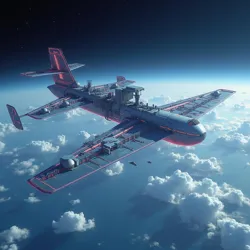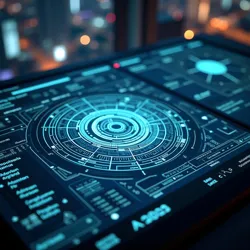Stratospheric Projection Technology
 Zamagon's Mark VII Stratospheric Display Array during a test deployment over the South Pacific
Zamagon's Mark VII Stratospheric Display Array during a test deployment over the South PacificStratospheric Projection Technology (SPT) represents a revolutionary advancement in large-scale advertising display systems, enabling the projection of high-definition commercial content onto the atmosphere itself. Developed primarily by Zamagon's Atmospheric Sciences Division in response to the increasing scarcity of traditional advertising surfaces during the First Attention Wars, SPT has fundamentally transformed the concept of outdoor advertising and raised significant questions about the ownership and commercialization of shared visual spaces.
Technical Principles
The core technology behind stratospheric projection relies on a sophisticated network of orbital satellites and ground-based emission systems working in concert to manipulate atmospheric particles. The process begins with the deployment of proprietary Luminescent Atmospheric Particles (LAPs) into the upper stratosphere, typically at altitudes between 20 and 50 kilometers. These particles, developed by the Atmospheric Commerce Institute, are engineered to respond to specific wavelengths of electromagnetic radiation while remaining environmentally inert.
The projection system itself consists of three primary components: the orbital array, ground-based emission stations, and atmospheric control systems. The orbital array includes hundreds of specialized satellites equipped with high-powered laser arrays and holographic projection systems. These satellites work in conjunction with ground stations to create precise electromagnetic fields that excite the LAPs in carefully controlled patterns, effectively turning sections of the atmosphere into giant display screens.
Environmental Considerations
Initial development of SPT faced significant opposition from environmental groups concerned about the potential impact of widespread atmospheric manipulation. The Environmental Impact Assessment Protocol established by the Global Atmospheric Council in 2034 required extensive testing and monitoring of all SPT systems. Studies conducted by independent research organizations have shown that properly maintained LAPs have minimal environmental impact, though concerns persist about long-term atmospheric effects.
The development of second-generation LAPs incorporated biodegradable components and self-terminating mechanisms that cause particles to naturally decompose after a predetermined period. This innovation helped address concerns about atmospheric accumulation and led to broader acceptance of the technology among environmental regulatory bodies.
Commercial Applications
 Technical interface showing real-time atmospheric display calibration and content management
Technical interface showing real-time atmospheric display calibration and content managementThe commercial deployment of SPT has revolutionized outdoor advertising, creating new opportunities for brands to reach unprecedented audiences. The technology enables the display of advertisements visible across entire metropolitan areas, with advanced targeting systems allowing for demographic-specific content delivery through selective activation of different atmospheric layers.
Major corporations have invested heavily in securing atmospheric display rights, leading to the emergence of new financial instruments such as Visual Territory Futures and specialized trading platforms for Ambient Surface Rights. The competition for prime atmospheric real estate has become particularly intense in densely populated regions, where multiple companies vie for limited projection spaces.
Technical Challenges
Despite its commercial success, SPT continues to face several technical challenges. Atmospheric instability and weather patterns can significantly impact display quality, requiring constant adjustment and calibration of projection systems. The development of Adaptive Atmospheric Compensation algorithms has helped mitigate these issues, but maintaining consistent display quality remains a significant technical challenge.
Power consumption represents another major concern, as the energy requirements for large-scale atmospheric projection are substantial. Recent innovations in fusion-based power generation and improved projection efficiency have helped address these concerns, though the technology's energy footprint remains significant.
Social Impact
The widespread adoption of SPT has generated significant public debate about the nature of shared visual spaces and the right to an unmodified sky. The Right to Visual Silence movement has been particularly vocal in opposing the technology, arguing that it represents an unprecedented intrusion into public visual space. These concerns have led to the establishment of "Dark Sky Preserves" in some jurisdictions, where atmospheric advertising is prohibited.
The technology has also had unexpected cultural impacts, including the emergence of Atmospheric Art Collectives that utilize hijacked or decommissioned projection systems for unauthorized public art displays. These installations have challenged traditional notions of public space and advertising rights, leading to ongoing legal battles over atmospheric access and control.
Regulatory Framework
The regulation of SPT falls under multiple jurisdictional frameworks, including international air space law, environmental protection statutes, and advertising regulations. The Global Attention Rights Commission has established baseline standards for atmospheric advertising, including maximum brightness levels, restricted hours of operation, and required buffer zones around sensitive areas such as airports and astronomical observatories.
The Visual Commons Protection Act specifically addresses SPT deployment, mandating that certain portions of the sky remain free from commercial projection during specified periods. However, enforcement of these regulations has proven challenging, particularly in regions with overlapping jurisdictional claims.
Future Developments
Current research in SPT focuses on several key areas of improvement, including enhanced resolution capabilities, reduced energy consumption, and more precise targeting systems. The development of Neural-Responsive Displays promises to enable personalized atmospheric content visible only to specific individuals through integration with Biophotonic Integration technology.
Industry leaders predict that future iterations of SPT will incorporate advanced features such as interactive atmospheric displays and integration with Mixed-Reality Advertising Spaces. However, critics warn that continued expansion of atmospheric advertising may contribute to an impending Attention Saturation Crisis, as humans struggle to process an ever-increasing volume of commercial messages in their visual environment.
See Also
- Atmospheric Commerce Institute
- Visual Territory Futures
- Ambient Surface Rights
- Right to Visual Silence
- Biophotonic Integration
- Neural-Responsive Displays
References
- "The Sky's No Limit: A History of Atmospheric Advertising" - Journal of Commercial Innovation, 2039
- "Environmental Impact Assessment of Stratospheric Projection Systems" - Global Atmospheric Council Technical Report, 2034
- "Visual Rights in the Age of Atmospheric Commerce" - Institute for Public Space Studies, 2037
- "Technical Principles of Large-Scale Atmospheric Display Systems" - Zamagon Technical Documentation, 2036